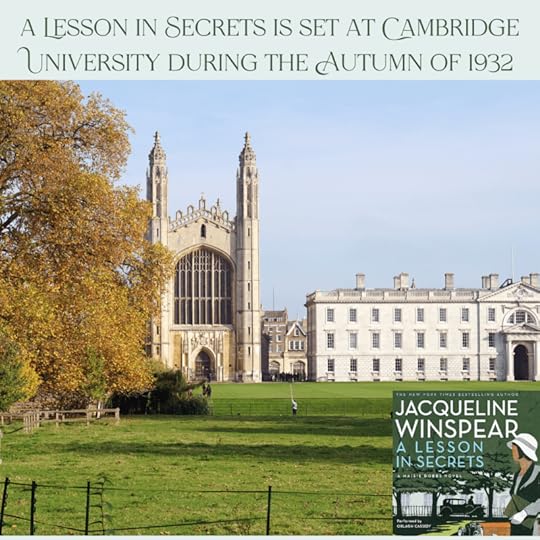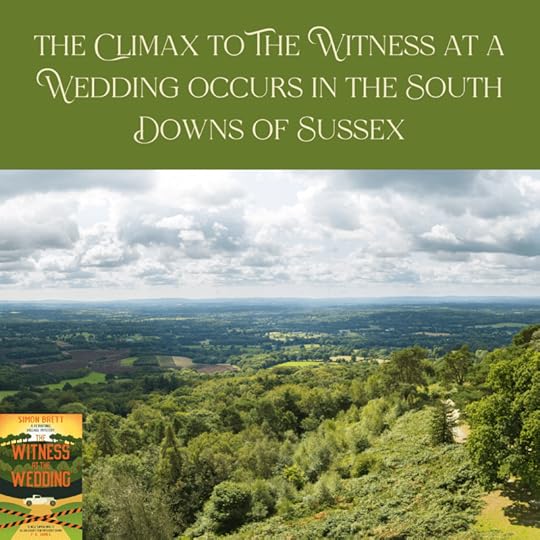Cynthia Sally Haggard's Blog: Cynthia Sally's Blog, page 7
March 18, 2025
Adventures in England and Wales 2013
By 2013, my mother was in failing health and so I spent a month with her from March to April that year.
As I may have mentioned before my mother spent the years before her last illness living with my sister and brother-in-law on the Wirral, that peninsula of land that lies between the Mersey and Dee rivers. If you look in one direction (across the Mersey) you see Liverpool. If you look the other way (across the Dee) you see the Welsh hills. And so, while my sister and brother-in-law took a much-needed vacation in Scotland, I hired a car so that I could drive my mother around. And that is how we found the charming “castle” of Stokesay in Shropshire in the Welsh Marches.
For those of you who do not know, the word March in this context is very similar to the German Mark and it means Borderland. In the British Isles there are two sets of marches. There are the borderlands between Wales and England called the Welsh Marches. And there are the borderlands between Scotland and England called the Scottish Marches. Both areas experienced a great deal of turbulence during the Middle Ages when at least one King of England was attempting to do a little ethnic cleansing on his Celtic neighbors.
Stokesay itself is an interesting name, because it combines the word Stoke, meaning cattle ranch, and Say (or de Say), the name of the family that occupied it from the beginning of the 1100s. What makes Stokesay so glorious is that not only do you have the Medieval castle, you also have the wonderful 17th-century gatehouse.
Today, the castle is a tranquil oasis of calm. But in its heyday, the serene courtyard was a hubbub of activity, with artisans such as blacksmiths plying their trade, while the washerwomen did the laundry, carts arrived and departed with goods, and visitors appeared at every and any hour on horseback and in carriages.
If you don’t know this part of England, I suggest you visit it. Shropshire had a turbulent past, but nowadays is known for its gorgeous countryside, as well as its various myths and legends.
 The post Adventures in England and Wales 2013 appeared first on Cynthia Sally Haggard.
The post Adventures in England and Wales 2013 appeared first on Cynthia Sally Haggard.
March 14, 2025
COSTANZA by Rachel Blackmore
COSTANZA by British author Rachel Blackmore is based upon the true story of a woman who became the muse and mistress of Gianlorenzo Bernini (1598-1680), the acclaimed sculptor. So besotted was he with this young woman who was about 16 years his junior, that he created a sculpture of her.
It sounds so romantic to have a famous and powerful man devote so many hours to creating this extraordinarily alive portrait of this young woman (Costanza would have been in her late teens and early twenties in the 1630s when the sculpture was created.) But as is so often true, there was a dark side to this tale.
Naturally, Gianlorenzo Bernini considered Costanza to be his property, even though she was actually married to one of his workmen. And so when poisonous little brother Luigi Bernini begins to stalk Costanza, Gianlorenzo bristles. But Gianlorenzo is so powerful, no-one actually thinks that Luigi will actually seduce his brother’s mistress.
But that is exactly what Luigi does and the fallout of that decision reverberates across 17th-century Rome.
Needless to say, the person who suffers the most from all of this is Costanza, whose beauty is ruined in horrifying retaliation by the great sculptor himself, who (of course) employs someone else to slash her face with a razor. Of course, Costanza is arrested and sent to a nunnery to do penance, even though the Bernini brothers, whose crimes are far greater, go free with just a slap on the wrist. (Gianlorenzo has to pay a fine and a promise to get married.)
Finally, Costanza is set free and sent back to her kind-hearted husband Matteo Bonarelli, where she spends the rest of her life (she died in 1662) helping him run an antiquities business.
Given the operatic nature of this story (onlhy lightly fictionalized by the author) we would expect there to be no difficulty in milking every aspect for tension.
And yet I found the novel curiously flat, in contrast to many readers.
Was it because I experienced it as an audiobook and the narrator did not convey the emotional dynamics clearly enough? Or was it because of how the novel was written, a texture of unceasing chatter, a wall of words, with no space in which to react to the events as they unfolded?
 The post COSTANZA by Rachel Blackmore appeared first on Cynthia Sally Haggard.
The post COSTANZA by Rachel Blackmore appeared first on Cynthia Sally Haggard.
March 11, 2025
Adventures in Paris 2012
In 2012, I was lucky enough to spend the month of June in Paris. Every day, I rose from my bed in a rental apartment in the Fifth Arondissement (the neighborhood that contains the Sorbonne) and set out to explore Paris, leaving my husband happily ensconsed in a Parisien café arguing philosophy with one (or two) of his many friends.
Of course, I visited the Jardin des Plantes. Of course, I wended my way through the Jardin du Luxembourg past the Medici fountain. If you have been to Paris, you know how civilized French parks are. They don’t have just park benches in them, the way they do in London. Non! Parisien parcs have round metal tables and elegant chairs all painted a light green, which is somehow the perfect color.
Because I was able to spend a whole month in Paris, I was able to visit some non-touristy areas. For example, I discovered the 73 bus (the soixante-treize in French) that started at the Musee d’Orsay and took you across the Place de la Concorde ~ that frightening mélange of traffic that pours in from every which way, which no pedestrian should attempt to cross ~ to Neuilly.
Neuilly, once a charming village, is now on the outskirts of Paris, on the other side of the Péripherique, another nightmare of traffic if you are driving a car. Neuilly is still charmiing (many rich people live there), but just as Georgetown in Washington DC is spoiled by the tall towers of Rosslyn, so Neuilly is marred by the tall towers of La Défense, a major business district that houses the usual sorts of things, including many insurance companies.
If you are not afraid of speaking French, I can highly recommend spending some time in Paris, just wandering around. You will find many interesting things!
 The post Adventures in Paris 2012 appeared first on Cynthia Sally Haggard.
The post Adventures in Paris 2012 appeared first on Cynthia Sally Haggard.
March 7, 2025
A LESSON IN SECRETS ~ MAISIE DOBBS #8 ~ Jacqueline Winspear
A LESSON IN SECRETS finds Maisie Dobb’s career as PI taking an exciting new turn when she is recruited by the British Secret Service to pose as a Philosophy Professor at Cambridge University. Her remit is to discover if there is anything going on that is “not in the interests of His Majesty’s Government.”
And so author Jacqueline Winspear invents the fictional St. Francis college, named after St. Francis of Assisi and dedicated to peace. Maisie Dobbs arrives in the Autumn of 1932 to carry out her duties, and rather to her surprise finds that she is a popular teacher, who enjoys spending time with her students. The founder of the college – Greville Liddicote – is regarded as a hero in Pacifist circles for writing a children’s book during the Great War that questions the whole idea of fighting. Needless to say, the publication of this book caused ructions, and lead to at least one mutiny.
While the above-mentioned is completely fictional – there is no St Francis College at Cambridge University, and a children’s book did not cause a mutiny – nevetheless it does capture the Zeitgeist of the time. As war progressed and as losses mounted higher and higher with the British army experiencing nearly 60,000 casualties on the first day of the Battle of the Somme (1 July 1916), it is scarcely surprising that the men were increasingly reluctant to fight. I have been to the Somme myself and understand that British and French generals were ordering their men up out of the trenches and into a hail of gunfire from the German army which had captured all of the high ground. Ordering young men to an almost certain death seems entriely crazy. And yet, that was what the First World War was like. No wonder that so many people – including war poets Siegfried Sassoon and Wilfried Owen – were so furious.
And so it is true, that by 1917, the French generals were finding it increasingly impossible to get their troops to fight as mutinies within the French Army were legion. Somehow the powers-that-be managed to conceal this fact from the British Army, which was not that far away, and was more biddable.
It is also true that there were many conscientious objectors during the First World War, including philosopher Bertrand Russell. True also that these people were treated with the greatest disdain as the majority saw their refusal to fight as the disgraceful behavior of cowards. (At least 250 British soldiers were shot for desertion.) Of course some of these people were suffering from what was then termed “Shell Shock” or “Neurasthenia.” Today we call the condition PTSD.
But what really shocked me was the notion that so many young people in Britain in 1932 were already admirers of Hitler. Young people formed organizations dedicated to his ideaology. Young people defended his views in debates. What is so shocking that all of this took place before Adolf Hitler became Chancellor of Germany in January 1933.
And what did the parents and grandparents of these young people think? Unfortunately, too many of them told themselves the Nazis posed no threat, because they didn’t do anything violent. And wasn’t it just a passing fad anyway? The real danger, the powers-that-be told anyone who would listen, was the Red Menace.
And so, Britain drifted into the disaster of World War II.
 The post A LESSON IN SECRETS ~ MAISIE DOBBS #8 ~ Jacqueline Winspear appeared first on Cynthia Sally Haggard.
The post A LESSON IN SECRETS ~ MAISIE DOBBS #8 ~ Jacqueline Winspear appeared first on Cynthia Sally Haggard.
March 5, 2025
Adventures in Norway 2012
In September 2012, my husband became Visiting Professor at the University of Oslo, and so we spent the Fall in Oslo.
The university found us lodgings in the Bjorvika Apartments, next to the main railway station and not far from the Opera House. Over the ensuing years, in which we visited Oslo many times, these apartments remained my favorite place. Not only were they centrally located, but they were so beautifully designed.
While my husband took up his duties at the university, I put on my hiking boots and walked and walked.
It is always amazing when a large city has a place of natural beauty, in which the inhabitants can go to breathe. There are two such places in Oslo. One is the Aker River, which flows through the old town, and possesses many hiking paths and trails. The other is Maridalsvannet, a large lake to the north of the city. It is a gem. In winter, there are paths for snow-shoeing and slopes for skiing. In the summer, you can take in the golden sunlight spilling through the leaves of the forest that surrounds it and glinting off the clear waters.
If you have never visited Oslo before, you should really try it.
 The post Adventures in Norway 2012 appeared first on Cynthia Sally Haggard.
The post Adventures in Norway 2012 appeared first on Cynthia Sally Haggard.
February 28, 2025
AMERICAN EMPRESS by Nancy Rubin ~ A Book Review
Marjorie Merriweather Post (1887-1973) led a long and interesting life that encompassed two world wars, three daughters and four marriages. I generally do not enjoy reading biography as too often it can be a dry recital of the trivia of someone’s life, but I have to say that Nancy Rubin in her biography of Mrs. Post, titled AMERICAN EMPRESS, has done a wonderful job in making it interesting. There was much I did not know about Mrs. Post. I didn’t realize that she grew up in Battle Creek Michigan, or that her father was an entrepreneur. All I knew about her was her wonderful collection of Russian porcelain and religious icons that are in the museum that used to be her home, here in Washington DC.
It is odd to reflect now, here in the 21st century, how people used to rush into marriage. Mrs. Post was married four times. I could understand why she married Edward Close (she was only eighteen), E. F. Hutton (he was the love of her life) and Joe Davies (he was interesting), but I must say I didn’t see the point of her marriage to Herbert May. But then women were made to feel that they couldn’t go out if they didn’t have some sort of male companion, and although her daughters encouraged her not to marry her male escorts, she herself was of an era when rigid notions of male-female relations prevailed.
Marjorie never did have much luck with husbands. She divorced two of them for infidelity, and the other two because, in their different ways, they cramped her style. Many of her friends speculated about why she was never happy for long in her marriages.
One of her friends remarked, “Marjorie, you could run General Motors. You could run U.S. Steel. You could run anything. You’re the smartest woman I know. But why do you have so much trouble with husbands?”
“Clare, I honestly don’t know. Ain’t it hell?” Marjorie is reported to have replied.
But the answer of course is that from the fact that you have formidable organizational skills and a steel-trap mind – as Marjorie did – it doesn’t at all follow that you will have a happy marriage. Because what is needed is a totally different kind of intelligence, what we now refer to as EQ or emotional intelligence.
This is not to say that Marjorie didn’t have any EQ – she had good relationships with all three of her daughters – but she didn’t have enough of it to offset all of her millions.
Because those millions, in my opinion, lay at the heart of all of her problems with her husbands.
 The post AMERICAN EMPRESS by Nancy Rubin ~ A Book Review appeared first on Cynthia Sally Haggard.
The post AMERICAN EMPRESS by Nancy Rubin ~ A Book Review appeared first on Cynthia Sally Haggard.
February 26, 2025
THE WITNESS AT THE WEDDING ~ Fethering Mysteries #6 ~ by Simon Brett
Finally, Carole Seddon has something to make her happy. Her son Stephen ~ with whom she has an awkward relationship ~ has announced his engagement, and his wife-to-be is someone that Carole not only approves of, but actually likes!
For those of you who do not know, Carole Seddon is a well-off matron in her fifties, who is neurotic in a typically British sort of way. Not for her all those messy emotions surrounding her relationship with her son, and her painful breakfup with her ex. No, this thin-skinned woman uses WILLPOWER to SQUASH all of her irritating FEELINGS.
And so, of course, they come back to bite her at suitably inappropriate moments.
Then Gabby comes into her world. The young woman is well-educated, charming, and poised, and it is clear that Stephen adores her. Plans for the wedding are set in motion. But then things, inevitably, start to go wrong.
Gabby becomes ill. She is plagued by serious back pain, and at times looks exhausted, so at odds with the bubbly girl that Carole first met. When Carole meets her parents, it is clear that something is not right. Father Howard is a perfectly pleasant man who would contribute more to the conversation if he were not so deaf. But what about Marie, Gabby’s French mother? Why is she so quiet? Why so self-effacing to the point of being invisible? Why does she look terrified? What can possibly upset her so much?
It turns out that the answer is, as so often, The Past.
Gabby’s family has had its share of tragedies, including a murder that happened thrity years ago. The young woman was Marie’s best friend, and since her murder Marie has never been the same. For, surprisingly enough, Marie was just as bubbly and full of life as her daughter is now.
Carole is concerned. She has genuinely become very fond of Gabby, and senses that the past is swirling around her duaghter-in-law-to-be in a sinister fashion. And so she consults next-door-neighbor Jude.
What the two women find is not only who was responsible for the murder, but a chilling tale of wreckage that includes wrongful imprisonment, manipulation, and secrets.
 The post THE WITNESS AT THE WEDDING ~ Fethering Mysteries #6 ~ by Simon Brett appeared first on Cynthia Sally Haggard.
The post THE WITNESS AT THE WEDDING ~ Fethering Mysteries #6 ~ by Simon Brett appeared first on Cynthia Sally Haggard.
February 21, 2025
Adventures in Firenze & Torino 2012
As a young woman, I suffered from crippling anxiety, and was not able to finally free myself from that condition until I turned fifty.
In 2012, I had the opportunity to visit the City of Florence and luckily for me, my best friend Pam was there at the same time. She wanted to visit the famous Duomo and while there we were invited (for some extra money) to climb up to the top of the Duomo. Pam was game to go, so I took a deep breath and followed her up the stairs.
At the beginning, it wasn’t bad. We took stairs that were inside the cathedral and as we rose higher and higher, we were able to see the magnificent paintings on the ceiling of the dome. At that point the stairs changed and we started to climb up inside the dome. This being Italy, there was (of course) no one-way system, meaning that those going up were having to negotiate with those going down. Naturally my heart began to flutter, the unfortunate signs of a panic attack.
But I took more deep breaths and eventually Pam and I found ourselves able to walk around the outside of the dome. It was a magnificent May day (I think it was May 10th) and I took a whole bunch of photos of Firence and the surrounding countryside. My favorite picture is of the bell-tower or Campanile which is on the image.
Eventually, Pam and I descended to the street level, I thrilled that I’d actually made it all the way up there without suffering from claustrophia, vertigo or a panic attack. I couldn’t have made that climb without her.
A few days later, I made my way to Turin, home of the 2006 Winter Olympics. On my collage, you can also see the Mole Antonelliana, the symbol of Turin, which started life as a synagogue and is now the Museum of Film.
 The post Adventures in Firenze & Torino 2012 appeared first on Cynthia Sally Haggard.
The post Adventures in Firenze & Torino 2012 appeared first on Cynthia Sally Haggard.
February 19, 2025
A SONG TO DROWN RIVERS by Ann Liang ~ A Book Review
I was already amazed by the beautiful prose and the richness of the characters in A SONG TO DROWN RIVERS, so I was curious. Who is the author?
Turns out that Ann Liang has a page in Wikipedia dedicated to her. She is described as a Chinese-Australian author, who was born in 2000. That makes her only 24. How could she possibly write so well about grief and tragedy?
But then, Ms. Liang has probably not had the adolescenese of many Americans. She has probably not spent her time getting wasted at parties. Not because there aren’t any such things in Beijing China, but because she has been too busy writing. Already she has THREE YA books under her belt ~ IF YOU COULD SEE THE SUN, THIS TIME IT’S REAL and I HOPE THIS DOESN’T FIND YOU.
A SONG TO DROWN RIVERS is her first foray into adult fiction. It is a retelling of the Legend of Xishi (pronounced ZEE-shuh), one of the Famous Four Beauties of the Spring and Autumn period. Set in the Fifth Century BCE, it tells the story of a great beauty who acted as a spy at the court of King Fuchai of the Kingdom of Wu. Xishi is from Yue, a rival kingdom to the south, and her goal is to destroy Wu, so that King Goujian of the Yue can take it over. This actually happened in 473 BCE. What became of Xishi after she’d completed her task is unknown. But I think you will find the end of this volume shocking. Five Stars.
 The post A SONG TO DROWN RIVERS by Ann Liang ~ A Book Review appeared first on Cynthia Sally Haggard.
The post A SONG TO DROWN RIVERS by Ann Liang ~ A Book Review appeared first on Cynthia Sally Haggard.
February 14, 2025
Adventures in Germany 2012
During 2012, I explored Germany for the first time in many years. I had previously been there thirty years before for a honeymoon with my first husband who spoke fluent German. This time, I went by myself and took the opportunity to explore Dresden and the Sächisiche Schweiz (Saxon Switzerland) a charmingly hilly region right up against the Czech Republic.
I speak what I call Hotel German, which means that I know enough to exchange greetings and ask for a bar of soap. But I cannot hold a conversation with anyone. There I was, by myself, trying to figure out what the train fare was from Dresden to Pirna, so that I could get on the little tram that took us sightseeing in the Saxon Alps. But of course, it was all in German. So I bought a ticket that I thought was right, and boarded the train.
Oh dear, what trouble I got myself into! The female guard was not at all happy with me once she figured out that I had underpaid for my ticket. She stood there, glaring at me while she let loose her tirade. As I mentioned before, I know only a very little German. So Ii was unable to understand what she was saying (fortunately.) But it was obvious that she was very upset with me.
Once she paused to draw breath, a man behind me raised his hand, and they got into a more moderate exchange. After they’d finished talking, he came and sat down beside me and explained – in perfect English – what I had done wrong. Apparently he had promised the guard that he would get off the train with me in Pirna, escort me to the nearest ticket machine, and make sure that I paid the full amount.
I smiled sweetly, and told him that of course I would do that.
And so it was. He led me to the ticket machine at Pirna, ensured that I paid the difference, said “goodbye” and wandered off.
I can’t think of any other country where this would happen. But perhaps I am wrong? Do you have any amusing stories to share about travel mishaps?
 The post Adventures in Germany 2012 appeared first on Cynthia Sally Haggard.
The post Adventures in Germany 2012 appeared first on Cynthia Sally Haggard.
Cynthia Sally's Blog
- Cynthia Sally Haggard's profile
- 129 followers



